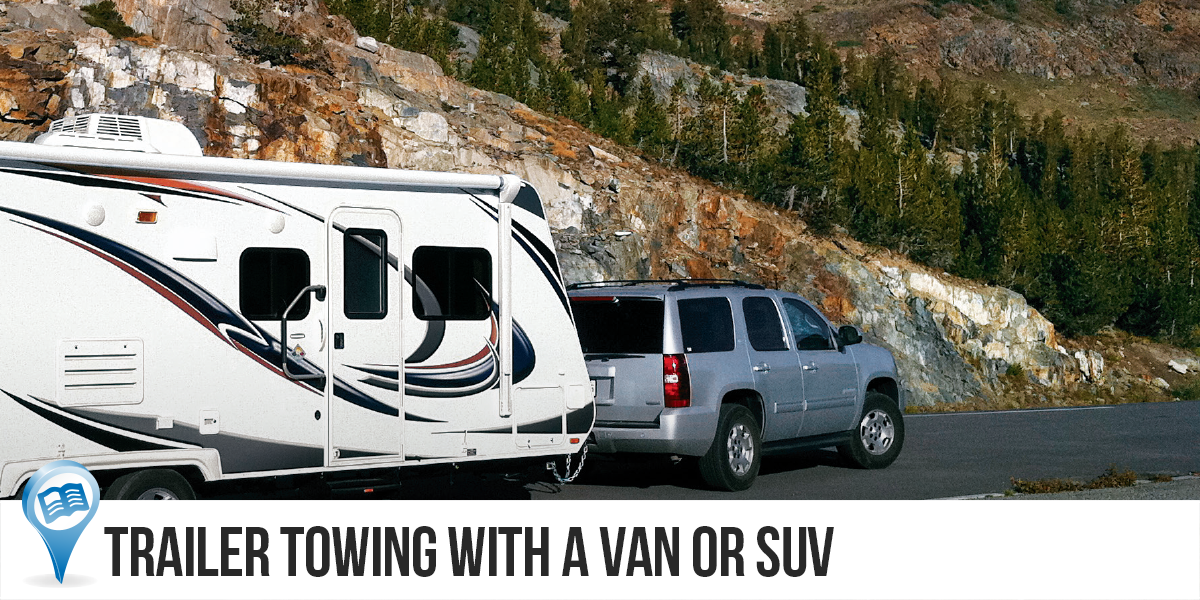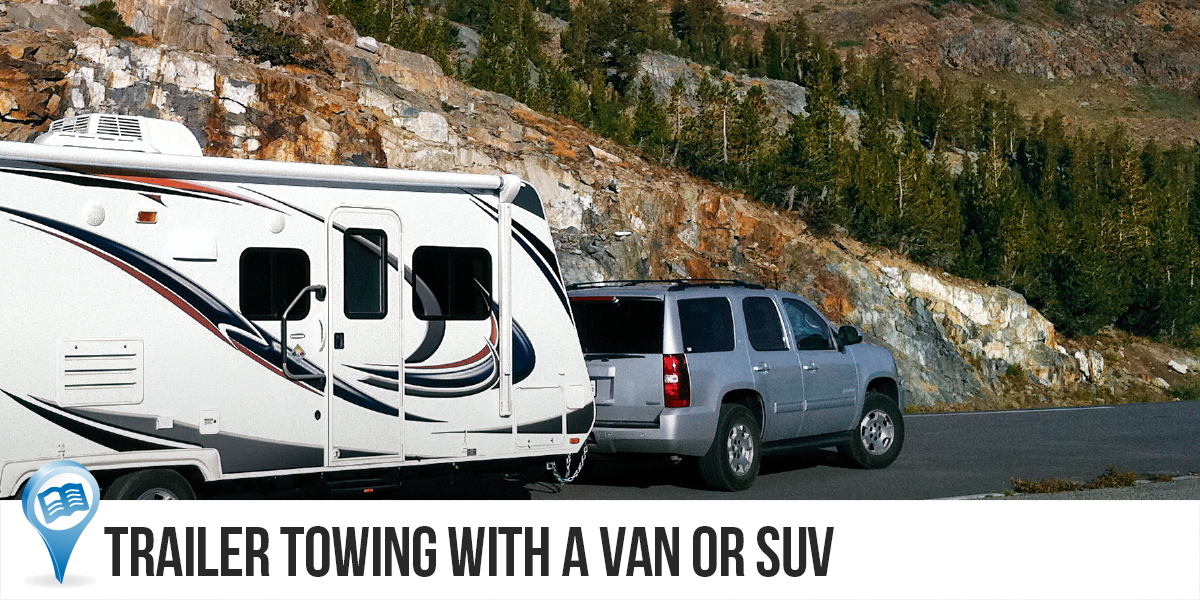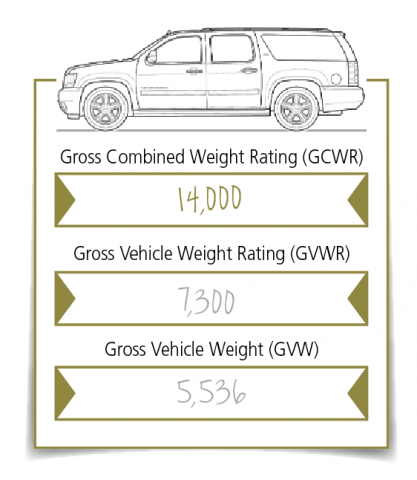
By Dave Gray, Guest Contributor
After reading comments from families looking for SUVs or vans to tow family-size trailers, I set out to research this topic. My previous experience in searching for required information that SUV and van owners need to know has been frustrating. It’s difficult to know where to start, but I use the same resources the consumer would most likely use. Therefore, I hope I can provide you with the answers you need to know and show you how and where to locate helpful information. I will share my findings as I progress through this fact-finding trip.
The first resource I go to is the manufacturer websites to find the two most important ratings and the curb weight if the scaled weight of a tow vehicle cannot be obtained. The three most important facts consumers need to know are the gross combined weight rating (GCWR—the maximum allowable combined weight of the tow vehicle and the attached towed vehicle), the gross vehicle weight rating (GVWR—the maximum allowable weight of the fully loaded tow vehicle, including liquids, passengers, cargo and kingpin or tongue weight of any tow vehicle) and the gross vehicle weight (GVW—the combined weight of the tow vehicle and all passengers and cargo pieces).
When purchasing a vehicle from a dealer, it may be difficult to know its actual GVW. Most buyers will be limited to using the published curb weight. Consumers need to keep in mind that the curb weight will never be the actual weight of a tow-ready vehicle. It will also not be accurate if the dealer has installed additional options on the vehicle.
The purpose of this article is to guide you through the process of obtaining a realistic towing capacity for any SUV or van. Since I am unable to cover every SUV or van, as an example, I have chosen the Chevrolet Suburban. The selected vehicle will be two-wheel drive, because they usually have the highest tow ratings. (For more information on tow ratings, visit http://fifthwheelst.com.)
I navigated to the Chevrolet Suburban “Specs” page, and then opened the “Trailering & Payload” submenu. All that is listed here is the GVWR, max conventional trailering and the max trailering with a trailering package. The problem with providing this information only, is that it never takes into account the size of the family riding in the SUV or van, or any additional cargo. These published towing capacities only represent the base or curb weight of the vehicle. Where is the GCWR listed? I could not find it.
Next, I navigated to the owner’s area and downloaded the 2017 Suburban owner’s manual. After opening the PDF file, I learned that the Tahoe and Suburban share the same manual. The trailer towing information is found in the “driving and operating” chapter.
On page 307 of the section entitled “Trailer Towing” is the additional need-to-know information. Here we find the GCWR and another important piece of information, the axle ratio. The Suburban and Tahoe frames are the truck 1500 series. The Suburban is the long wheelbase, and the Tahoe is the short wheelbase. Interestingly, the manual does not specify which wheelbase belongs to either vehicle. Only if you compared the two vehicles side-by-side would you be able to recognize it.
In the owner’s manual, it lists two axle ratios, 3.08 and 3.42. In my first Escapees magazine article, “My Truck Pulls It Just Fine, Truck Buyers Beware” (July/August 2016), I explained the gear ratio. The vehicle with the 3.08 ratio has a GCWR of 12,000 pounds, and the 3.42 ratio is 14,000 pounds. If you think you will be towing over a few mountain passes or hilly areas, I encourage you to purchase the SUV or van with the higher ratio. Additionally, this will more likely provide greater towing capacity.
One aspect of selecting an SUV or van for towing is the wheelbase length. The longer wheelbase will always be the best choice. Long wheelbase vehicles provide better towing stability, especially for longer trailers. (You can find a true story provided by Tahoe owners who shared the events of their hair-raising accident online at http://fifthwheelst.com/rv_accident_2006_tahoe.html).
Listed in this trailer towing section is the maximum trailer weight, also known as trailer weight rating (TWR). There are additional towing capacities listed here other than those shown on the website. However, I remind you that the maximum towing capacity is associated with the curb or base weight of the vehicle.
Another important weight that must be considered is the maximum tongue weight. The Suburban and the Tahoe both have a maximum tongue weight of 600 pounds. If you use a weight distribution hitch system, the maximum tongue weight increases to 1,000 pounds. According to the manual, a weight distribution hitch is required if the trailer weight is over 7,000 pounds. It is important to refer to trailer manufacturers’ recommendations.
Thus far, I had to use two separate resources to find GVWR and GCWR. I also note that the owner’s manual does not state the GVWR. With any vehicle you plan to purchase, it is best to obtain the GVWR directly from the certification label on the driver’s side pillar or door. Now, the last important question to answer is “How much does it weigh?”
I spent several minutes searching for the curb weight on the Chevrolet website and came up empty. As of this writing, Chevrolet does not have the 2017 trailering guide published. However, the 2016 guide did not have curb weight information either. I finally picked up my Android phone and asked Google, “How much does a 2017 Suburban weigh?” The results stated that the curb weight was between 5,586 and 5,822 pounds. I do not have a clue where that info came from, so I could not validate the resource.
At this point, I decided to call the local Chevrolet dealer and, frankly, it was a waste of 13 minutes of my time. The sales manager was arrogant and argumentative, and he was unwilling to provide specific information. He said that if I were interested in buying a Suburban, come on down and he would answer all my questions. After I had settled down, I called another dealership in the next city. The conversation was 180 degrees different. Not only did this manager find a Suburban with the 3.42 axle ratio in the towing package, he also provided the curb weight.
Thus far, I have discovered that this Suburban has these ratings: GCWR-14,000, GVWR-7,300 and it weighs 5,536 pounds.
Next, take these weights and enter them into the RV Tow Check app online (http://rvtowcheck.com). In addition to the curb weight, passenger and cargo weight need to be included. For a family of four, we will say the passenger weight is 480 pounds and the cargo in the back weighs 250 pounds. With all these weights entered into the app, the realistic vehicle towing capacity, with a 10–13 percent tongue weight, is 7,707 pounds. The actual towing capacity listed in the owner’s manual and online is 8,300 pounds.
I hope that you have come to realize that the weight of a tow-ready vehicle directly affects the maximum towing capacity or trailer weight rating (TWR). In every SUV or van owner’s manual, you should find a paragraph similar to this one: “Trailer Weight Rating (TWR) is calculated assuming the tow vehicle has only the driver [150 lbs.] and all required trailering equipment. The weight of additional optional equipment, passengers, and cargo in the tow vehicle must be subtracted from the trailer weight rating.”
Sounds like a simple calculation. Unfortunately, this method is not 100 percent accurate. Sometimes the results are too low, and other times it is too high. Is it in the ballpark? Last time I checked, ballparks are pretty big. The goals of safe towing are to keep the rig between the narrow highway lines and to stop safely.
Even if you do not use RV Tow Check to learn the realistic vehicle towing capacity, the next best thing you can do is weigh your vehicle to obtain the gross vehicle weight (GVW). Your tow vehicle should be fully loaded with all the expected passengers and cargo, as well as a full tank of fuel when you weigh at a local truck scale. Then subtract the GVW from the GCWR. This method works well for conventional towing; however, fifth-wheel towing requires an additional calculation.
I continued to research other brands, and the same problem of finding the required information exists with most SUVs and vans. The project required multiple phone calls, as well as e-mails to the manufacturer. I was amazed at how many salespeople do not even know the meaning of GCWR.
The prospects for RVing with large families in any SUV or van are limited, but not impossible. I did complete a page at the Fifth Wheel Street website covering various SUVs and vans that provide the best towing potential. Hopefully, this new listing will assist SUV and van buyers with their purchase.
After experiencing newbie problems as a full-time RVer, Dave quickly learned important lessons. Frustrated at the limited, simplified RV weighing techniques available online, he created a website geared for both the novice and seasoned RVers. Due to Gray’s research and safety training skills developed during years of military and other government services, this positioned him to develop user-friendly RV safety products and to provide important RV safety information.












